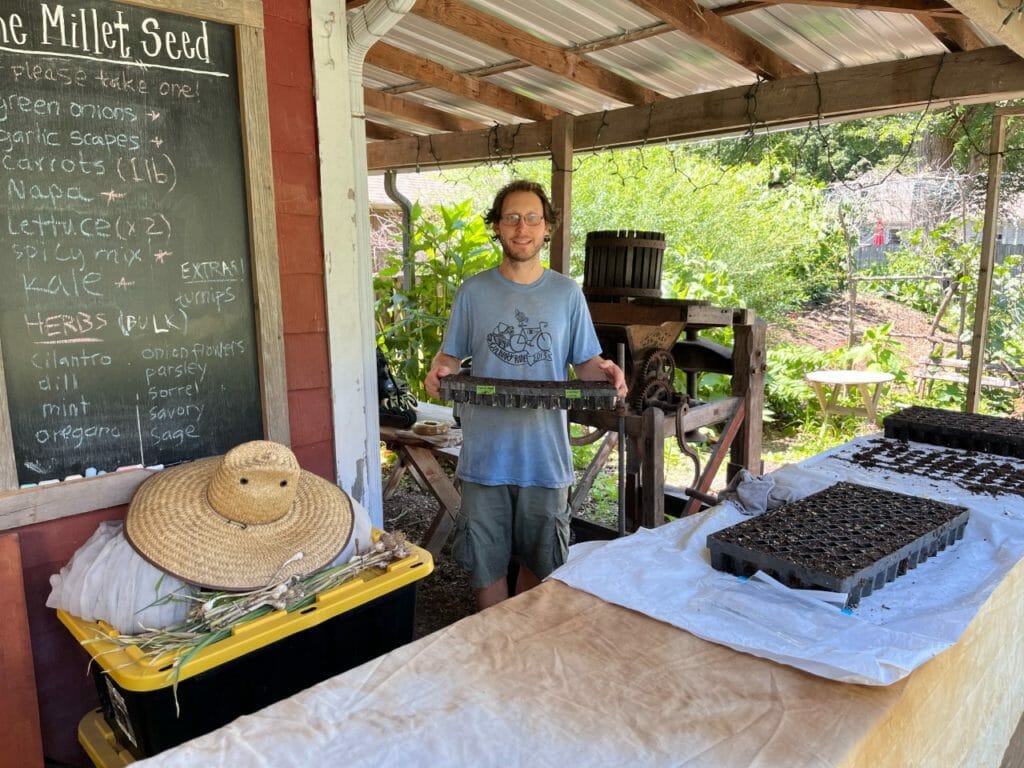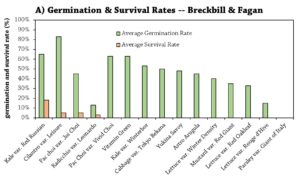This research was funded by Ceres Trust.
In a Nutshell:
- The objective of this trial was to determine which of several salad greens species are most cold tolerant for overwintering.
- Hannah Breckbill and Emily Fagan of Humble Hands Harvest and Jon Yagla of The Millet Seed farm seeded over 15 different varieties of salad greens and compared germination and survival rates.
Key Findings:
- At Breckbill and Fagan’s, cilantro (var. Leisure) and kale (var. Red Russian) exhibited the greatest germination rates – 83% and 65%, respectively – while parsley exhibited 0% germination.
- Only four of their 16 varieties survived winter but survival rates did not exceed 20%. For about half of Yagla’s varieties, germination rates hovered at or above 75%. All varieties had at least some plants survive, with survival rates of Vit Mache and claytonia exceeding 70%. Parsley and all three kale varieties likewise performed well.
- After additionally considering characteristics like bolting and flavor, Yagla plans to do fall seedings of claytonia and red oak leaf lettuce in the future. Breckbill and Fagan would consider trialing some varieties again in the future with additional protection (i.e. high tunnels).
Background
The difference between annual, biennial and perennial plants is simply the number of years they require to complete all stages of their life cycle. Seeds of tomato, an annual, are planted in the spring, undergo rapid vegetative then reproductive development throughout the summer, and then die before winter. Perennials begin in the same way, but undergo a dormant period between vegetative and reproductive development. Dormancy carries them through the cold winters before longer daylight hours and warmer temperatures trigger a break in dormancy and the onset of reproductive development. If the plant is a biennial, it would fruit and set seed then die before the next winter; but if it is a perennial it would live on in a similar fashion into the third year or longer. For the sake of maximizing time and space, farmers often grow biennials as annuals. This is possible because the parts we wish to consume – leaves, for example – are already harvestable in the first year.
In typical cooperator fashion, Jon Yagla, Hannah Breckbill and Emily Fagan were curious to see if they could fiddle further with plant life cycles. They wondered if they could plant biennial and annual salad greens in the fall, then overwinter them for spring harvest before they bolt. They hoped that by overwintering very young, immature greens they could trick the plants out of breaking dormancy and starting reproductive development the next spring and instead get good harvest early in the spring from rapid vegetative growth of young seedlings.
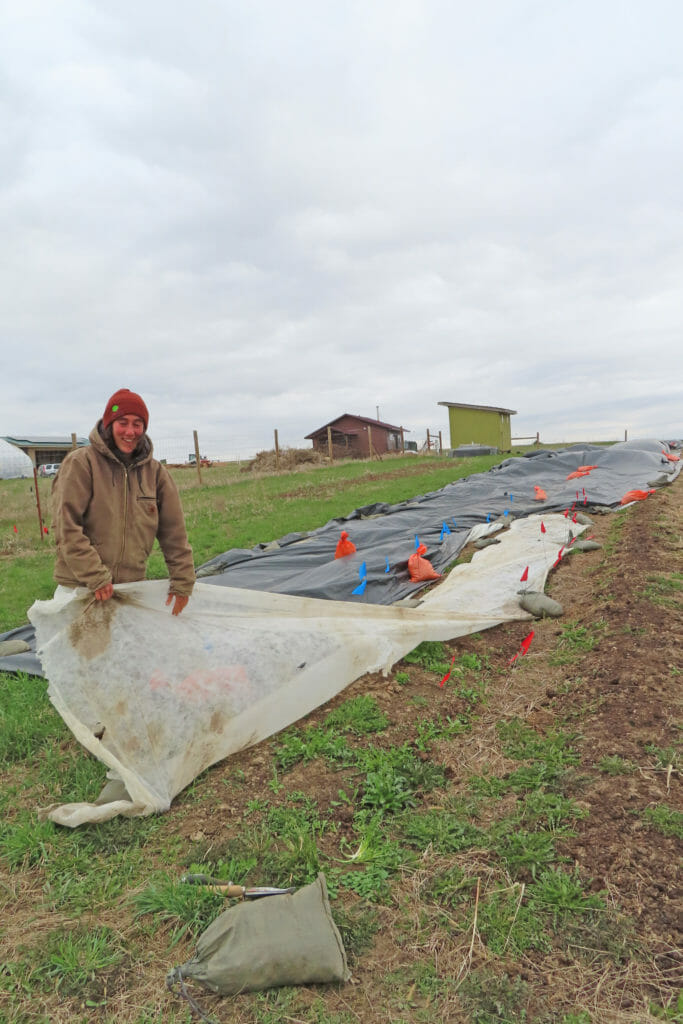
Emily Fagan manages to unveil their overwintered greens for a quick photo opp on a blustery day without sending the row cover flying cross-country. Photo taken April 28, 2022.
The objective of this trial was to determine which of several salad greens species are most cold-tolerant for overwintering. Jon Yagla commented, “I hope to have a better understanding of which greens, besides spinach and cilantro, overwinter well in Iowa. This will help with early greens production without the use of expensive high tunnels and living roots in the soil for longer periods of time, which is a goal for improved soil health.” Fagan added, “This will help us learn more about how to have a variety of greens ready to sell as early as possible in the spring.”
Methods
Design
For this trial Breckbill, Fagan and Yagla each chose a selection of cold-tolerant greens varieties to seed in late September 2021. For detailed management information, see Table 1, and for the full list of species and varieties planted at each site, see Figures 1 and 2. The growers planted two replicate plots of each variety. At both sites, the growers planted 20 seeds per plot in a single row measuring 2 ft in length, then covered plots with floating row covers. For a sample plot layout, see Figure A1.
Shortly after planting (Sept. 25, 2021), Yagla discovered severe damage to several plots caused by squirrels. On Oct. 8, he re-planted several plots. On December 15, after experiencing damage in another trial from deer feeding, Yagla added additional protection to his plots in the form of a caterpillar tunnel but removed one layer of row cover fabric to prevent overheating.
Measurements
The growers recorded the number of seedlings that germinated in each plot prior to first freeze in fall 2021. We then calculated germination rates by dividing the number of seeds planted by the number that germinated.
The subsequent spring, Breckbill, Fagan and Yagla counted the number of plants that survived after breaking dormancy. To calculate survival rates we divided the number of plants that survived by the number of seeds planted.
Data analysis
The growers were interested in sampling a large number of greens varieties to overwinter rather than comparing a small number. To encourage initial testing and to accommodate space constraints, two replications of each variety were planted rather than the standard of four replications. For this trial we used numerical comparisons rather than statistical comparisons to narrow down the number of species that might be best to test in future trials with thorough statistical analysis.
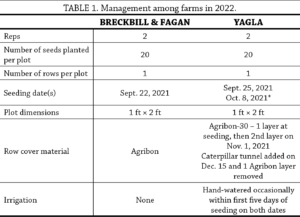
* Some plots were re-seeded after squirrels accessed plants underneath row cover and dug up portions of several beds.
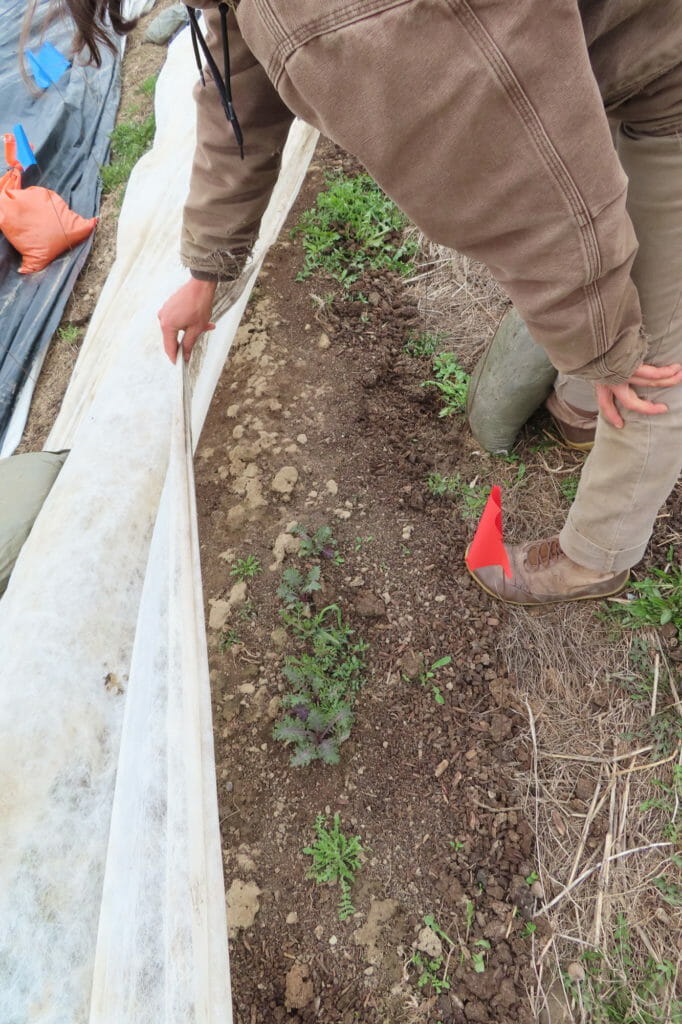
A close-up peek under the row cover at Hannah Breckbill and Emily Fagan’s reveals almost zero survival of their overwintered greens. Photo taken April 28, 2022.
Results and Discussion
Germination and survival rates
At Breckbill and Fagan’s, cilantro (var. Leisure) and kale (var. Red Russian) exhibited the greatest germination rates – 83% and 65%, respectively – while parsley exhibited 0% germination (Figure 1A). While germination rates were generally low, survival rates were abysmal. Only four of 16 varieties survived through winter, but their survival rates did not exceed 20%. Fagan offered several thoughts on why survival might have been low, saying “the plants might not have been big enough going into winter.” She wondered if a dry fall and no irrigation might somehow also have contributed to their lack of resiliency.
Yagla’s results were more favorable. For about half of the varieties he seeded, germination rates hovered at or above 75% (Figure 1B). All varieties had at least some plants survive, but Vit Mache and claytonia performed best with survival rates exceeding 70%. Parsley and all three kale varieties likewise performed well.
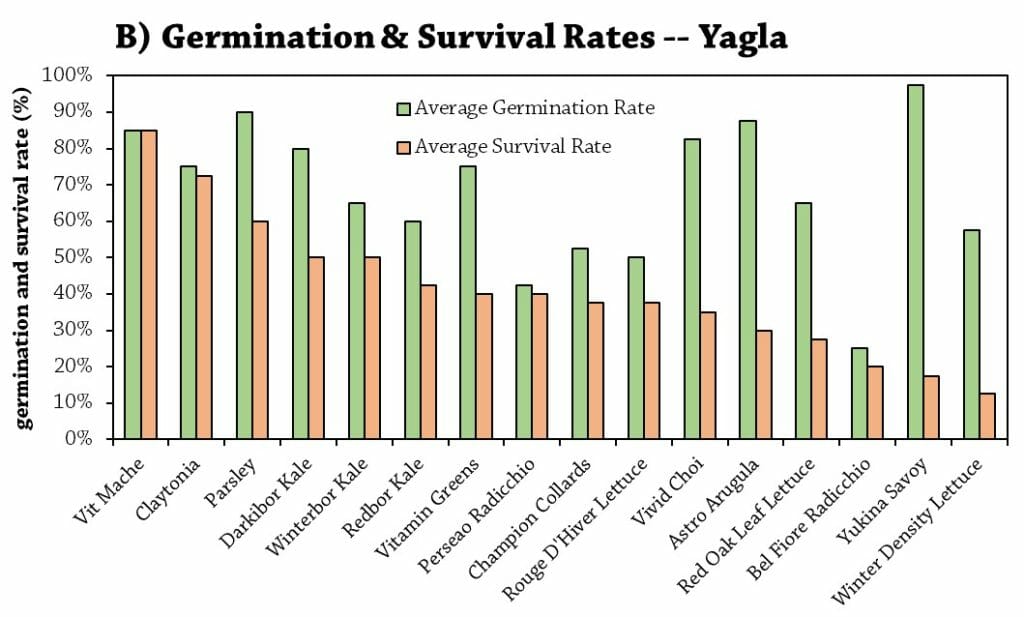
FIGURE 1. Germination and survival rates at (A) Hannah Breckbill and Emily Fagan’s farm, and (B) Jon Yagla’s farm.
While germination and survival rates provide valuable information, they are one part of a fuller picture. Yagla remarked, “There were some really good survival rates of over half, but the majority bolted pretty much immediately [in spring].” He offered the following observations in regard to bolting, flavor and ease of harvest:
- “Though all the hardy brassicas (kale, collards) survived, they bolted! I was hoping radicchio would do well but it bolted as well.”
- “Claytonia and Vit Mache both did well, but I wasn’t impressed with the Vit Mache. I would definitely overwinter claytonia. It was ready to harvest super early in the tunnel and could be good for harvesting overwinter as well.” Yagla said though both varieties bolted quickly, claytonia still tasted “really good” while Vit Mache did not. He added that Vit Mache’s small size at maturity made it difficult to harvest.
- Yagla was surprised the lettuces did so poorly but was impressed with the yield of red oak leaf lettuce. He commented, “I’m definitely going to try overwintering the red oak leaf lettuce again, but I’ll do transplants instead of direct-seeding.” Yagla also mentioned the possibility of planting it at a greater rate.
Conclusions and Next Steps
Many valuable observations were made as a result of conducting this trial. Yagla, who saw greater success than Breckbill and Fagan, reflected, “I have a much better understanding of which greens are suitable for a fall seeding and early spring harvest. I will try fall seedings of claytonia and red oak leaf lettuce for early spring harvest in the future.” Fagan and Breckbill, who farm further north and on a windy bluff, commented, “I suspect a lot of these varieties would have survived winter with more care. For example, receiving more water initially and being planted in a high tunnel instead of the field.” Though uncertain, Breckbill and Fagan would consider trying some varieties again. They added, “We liked this trial because it gave us space to try varieties we might not try otherwise. It was nice to have the accountability and the flexibility to be adventurous on our farm!”
Appendix – Trial Design and Weather Conditions

FIGURE A2. Mean monthly temperature and rainfall during the study period and the long-term averages at the nearest weather stations to Breckbill and Fagan (Decorah) and Yagla (Iowa City).[1]
References
1. Iowa Environmental Mesonet. 2022. IEM “Climodat” Reports. Iowa State University Department of Agronomy. https://mesonet.agron.iastate.edu/climodat/ (accessed October 2022).


